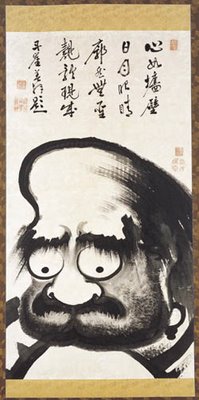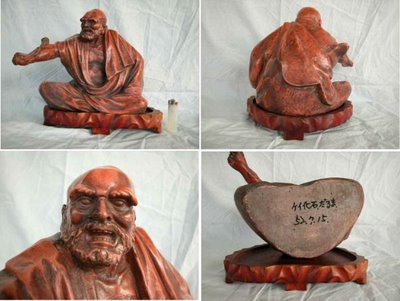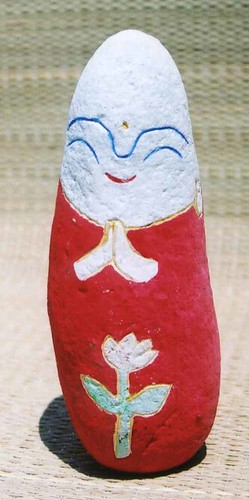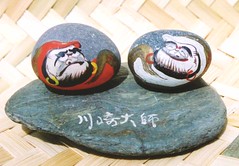Wasabi and its KIGO
:::::::::::::::::::::::::::::::::::::::::::::::::::::::::::::::::::::::::::::::::::::::::::::::::::::
Japanese Horseradish, Wasabi called DARUMA
だるまわさび 達磨山葵
The variety grown in fresh water (sawa wasabi 沢山葵) called "Daruma wasabi" is especially prized for its dark green color, size and the crisp taste.
静岡県は以前は「だるま」と呼ばれる太くて、色も味もいい品種をよく作っていましたが、狩野川台風(昭和33年)以来、この辺りも「真妻(まづま mazuma)」などの実生(みしょう)わさびの栽培が中心になっています。「真妻」は茎が紫色で、太く、風味がよく、今、チャンピオンのわさびです。
http://www.kameya-food.co.jp/wasabta01.html
:::::::::::::::::::::::::::::::::::::::::::::::::::::::::::::::::::::::::::::::::::::::::::::::::::::
Wasabia Japonica
Quoted from www.wasabia.ca
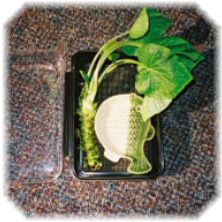
Fresh Wasabi is a highly prized culinary ingredient used mainly in elite restaurants and sushi bars in Japan. The demand for fresh Wasabi consistently exceeds the supply. So called 'Wasabi' paste is also popular in North American and Japanese restaurants and sushi bars, but what is distributed as Wasabi paste or powder is mostly an imitation product based on horseradish, Chinese mustard and food colouring.
What is Wasabi?
The wasabi plant (Wasabia japonica, also incorrectly equated to Eutrema japonica), a member of the cruciferous family, is native to Japan and is traditionally found growing in or by cold mountain streams. The earliest cultivation of wasabi in Japan dates back to the 10th century. The grated 'rhizome' or above-ground root-like stem of this plant has a fiery hot flavor that quickly dissipates in the mouth, leaving a lingering sweet taste, with no burning sensation.
Field Wasabi vrs. Stream Wasabi
There are two main strategies that are used in growing Wasabi. The higher quality Wasabi, both in appearance and taste, grows in cool mountain streams and is known as semi-aquatic or "sawa" Wasabi. Wasabi known as field or "oka" Wasabi is grown in fields under varying conditions and generally results in a lower quality plant, both in appearance and taste.
Varieties of Wasabi
The most popular variety of Wasabi is known as Daruma.
The majority of Wasabi grown by PCW is the Daruma variety, but the Mazuma variety is also being produced, for although it is somewhat less attractive in appearance, it has more heat than the Daruma.
Traditional Uses
Wasabi is a staple condiment in Japanese cuisine and is served with sushi and noodles, among other things. The leaves can be dried and used for flavour in foods such as salad dressing, cheese, and crackers; or pickled fresh in sake brine or soy sauce. A Wasabi wine is sold (more as a novelty) in some Japanese specialty stores as well as a higher alcohol content Wasabi liqueur.
Selecting Wasabi
Wasabi powders and pastes which one finds in grocery stores or Japanese restaurants are usually not real wasabi at all. Even the better restaurants generally use so-called wasabi which contains only a very small percentage of lower-grade wasabi or wasabi stems. What is usually known as wasabi is actually horseradish powder (dried and ground regular horseradish), mustard powder, with a little cornstarch and artificial food coloring. Because wasabi plants are peculiar and particular in their needs, real wasabi is more expensive and is considered a rare delicacy.
The Japanese export horseradish-based products as 'wasabi' because in Japanese, horseradish is known as 'seiyo' or 'western' wasabi. When horseradish was first introduced, the Japanese called it 'seiyo' wasabi because it's pungency is similar to wasabi. This is why horseradish is now being exported from Japan under the 'wasabi' name.
When selecting fresh wasabi for grating, choose fresh, cool, un-shriveled roots. When selecting fresh leaves of the wasabi plant use the same guidelines you would use for selecting salad greens; no sogginess or wilt, uniform color, etc.
Preparation
Wasabi adds a unique flavour and heat to foods, and can be served as a spice or an herb in a dish or as a condiment on the side.
Generally, the best results in preparing freshly ground wasabi are obtained by using a sharkskin grater or "oroshi". If a sharkskin grater is not available, ceramic or stainless steel surfaces can be used. Ceramic graters with fine nubs are preferable to stainless steel, but in either case, the smaller and finer the 'teeth', the better.
Using sharkskin as a tool for grating wasabi has been a practice in Japan since the earliest times, and is still regarded as the preferred method of obtaining the best flavour, texture and consistency in freshly ground wasabi.
Grating wasabi releases volatile compounds, which gradually dissipate with exposure to the air. Using a traditional sharkskin grater and keeping the rhizome at a 90-degree angle to the grating surface generally minimizes exposure to the air. In this way, the volatile compounds are allowed to develop with minimal dissipation. This combination of natural volatiles, consistency and texture distinguish fresh wasabi from the imitation varieties of powdered and paste horseradish, which have been mixed with Chinese mustard and green food colouring.
Once you have grated enough for the first 'session', pile the grated wasabi into a ball and let stand at room temperature for a few minutes to allow the flavor and heat to develop. The flavor will dissipate within a short period, so grate only what will be used within 15 or 20 minutes.
How To Grate Wasabi :
Rinse the rhizome under cold running water.
Scrape off any bumps or rough areas along the sides.
Scrub the rhizome with a stiff brush.
Cut the rhizome just below the leaf base and inspect the exposed flesh to ensure that it is a uniform green colour.
Grate the cut end against the grater surface, using a circular motion.
After use, rinse the rhizome under cold running water. If you are using a sharkskin grater, rinse it under cold running water as well and let it air dry.
Nutrition
As a member of the cruciferous family, wasabi contains the same cancer-fighting isothiocynates as its cabbage cousins. The American National Cancer Institute and the American Cancer Society have studied cruciferous vegetables extensively for years. They recommend that everyone eat several servings from this vegetable family each week to dramatically lower risk of all types of cancer. Researchers believe that one way the substances in cruciferous vegetables help prevent cancer is by helping the body eliminate excess hormones such as estrogen, thus reducing the risk of hormone-related cancers such as breast and prostate cancer.
© Published by City Farmer
Canada's Office of Urban Agriculture
http://www.cityfarmer.org/wasabi.html
More is here
Alternative Medicine : Wasabi

Iwasaki Kanen (1786-1842)
1828 in botanical encyclopedia
. wasabizuke わさび漬け(山葵漬け) pickled wasabi .
:::::::::::::::::::::::::::::::::::::::::::::::::::::::::::::::::::::::::::::::::::::::::::::::::::::
. Food vendors in Edo - 江戸の商売 .
wasabi uri 山葵売り vendor of Japanese horseradish

They were a kind of vegetable vendors.
:::::::::::::::::::::::::::::::::::::::::::::::::::::::::::::::::::::::::::::::::::::::::::::::::::::
..................... HAIKU
Japanese horseradish, wasabi 山葵
kigo for late spring
a radish paste piques the taste buds -- daruma's tears
"chibi" (pen-name for Dennis M. Holmes)
... Wabi, Sabi, Wasabi
xxxxxxxxxxxxxxxxxxxxxxxxxxxxx
betabeta ya wasabi sono mama tabemashita
hot and sticky night—
I ate some wasabi, as is
Nanami (Nana) Hayashi
http://www.worldhaikureview.org/3-2/treasuretrove_nh.shtml
:::::::::::::::::::::::::::::::::::::::::::::::::::::::::::::::::::::::::::::::::::::::::::::::::::
HAIKU
WASHOKU : Wasabi and more of its KIGO
Wabi and Sabi: Haiku and Japanese Aesthetics
:::::::::::::::::::::::::::::::::::::::::::::::::::::::::::::::::::::::::::::::::::::::::::::::::::::::::::::::::::::::::::
[ . BACK to DARUMA MUSEUM TOP . ]
[ . BACK to WORLDKIGO . TOP . ]
:::::::::::::::::::::::::::::::::::::::::::::::::::::::::::::::::::::::::::::::::::::::::::::::::::::::::::::::::::::::::::







































